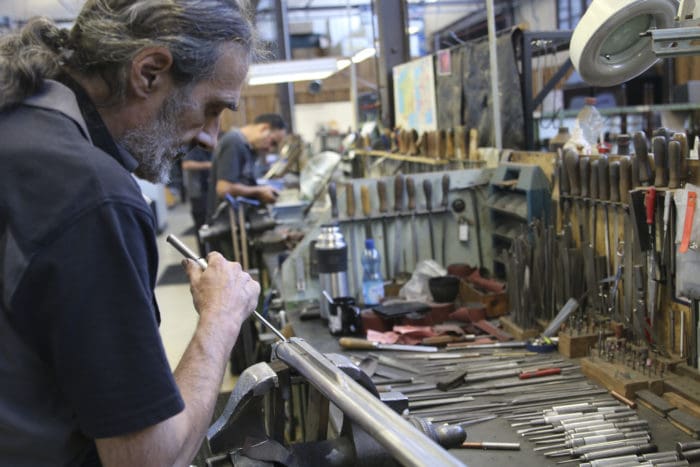The name St. Etienne is synonymous with weapon production. From the middle ages to the present, St. Etienne artisans, gunsmiths and factories have produced countless knives, swords and firearms. These weapons were designed for hunting, self-defense and/or military applications.
Verney-Carron is a lens through which one can view St. Etienne’s firearm production. The marriage of Claude Verney and Antoinette Carron represented a merger of two families whose legacy was gunsmithing. Their families’ artisanship extends back in time to Guy Verney who was producing shotguns in 1650. An examination of Verney-Carron thus reflects the wonderful history of weapon production in St. Etienne and France.
Though Verney-Carron is well-known as a manufacturer of assembly-line sport and security force firearms, my exposure to their work has been through their hand-made shotguns and rifles; both the side-by-side rifle in .450/400 Nitro Express and the 20 gauge side-by-side shotgun were delights to handle, photograph and shoot.
So, I was extremely excited when Jérôme Lanoue agreed to host my wife, Frances, and myself at L’Atelier Verney-Carron headquarters and factory.
Our time at L’Atelier began in Jérôme’s office-cum-display room. My interview of Jérôme will be featured elsewhere, but suffice it to say, he’s a passionate master gunsmith and hunter. He and I recounted some of our hunts, showing each other photos of animals taken as if they were our children (apologies to my actual biological children).
Soon, Frances and I found ourselves ushered into the ‘workshop’ in which much of the hand-made production occurs. Walnut stock blanks – obtained from a variety of regions – were stacked in several corners. Hand tools for wood- and metal-working adorned each of the benches occupied by the seven L’Atelier artisans.
We began our tour by watching the apprentice, Angelo, being instructed in the formation and installation of the rib of a side-by-side double rifle. His mentor was Laurent, the head of the workshop.
Angelo had completed a three-year program at a school where he learned the rudiments of gunsmithing. Before he would be trusted to work on his own firearms in L’Atelier, Angelo, will need to spend an additional four years as an apprentice.
Moving further into the workshop, we came upon Christophe – the head of technical applications – making fine adjustments on a trigger for a 28 gauge side-by-side shotgun. Again, no machine could be trusted to arrive at the exact shape required, so hand-filing was required.
Jean-Baptiste was our next ‘victim’. He specialized in woodwork. Final shaping of the stock was again being accomplished by meticulous handwork.
We encountered our second ‘Christophe’ at the next niche (he’s the one in the image at the top). Christophe was using a narrow chisel to round off the junction between barrels and action of a double rifle.
From Christophe #2, we moved on to Matthieu, who cleans and polishes all of the metalwork that’s destined for casehardening.
This stop within L’Atelier also provided an opportunity to view the work of the gifted engravers. These artisans, along with those who apply their skills in checkering and carving motifs into the stocks of shotguns and rifles, work off-site at their residences. Jérôme explained that he wants these master craftsman to work in quiet surroundings because of the absolute concentration that’s required.
The final stage of our tour within the workshop was appropriately with Chem. Chem is the last person who touches the firearms before they go to Jérôme for final approval; he could thus be considered ‘The Closer’.
We approached Chem as he was putting the finishing touches on the trigger assembly of a twin-triggered, double rifle. The steps we observed are a perfect model of the artisanship of L’Atelier Verney-Carron, and thus an ideal way to conclude our journey through the workshop.
Chem was just completing the trigger assembly as we approached his niche.
He next attached the exposed action to the barrels of the side-by-side rifle.
Attaching a pull weight gauge to each of the triggers in turn, Chem tested to see if the trigger pull required for a dangerous game caliber (approximately two pounds) had been achieved.
A glance at his gauge resulted in Chem shaking his head…
…quickly pulling apart the trigger mechanism…
…and meticulously removing a tiny bit more of the metal to allow a slight reduction of the pull weight.
I hope that the above description of the work performed at L’Atelier Verney-Carron gives you some idea of the unique place that this ‘workshop’ holds within the community of gunmakers. They stand alongside such storied names as Purdey, Holland & Holland, Westley Richards, Turnbull and Janz as producers of exquisite, custom firearms.
Because every one is fashioned by hand, each of their products has a unique lineage and form. This makes every firearm a heritage-piece for their owner. I have written this before, but it is worth repeating: vive la Verney-Carron!
Special thanks to Jérôme Lanoue and all of the workers in L’Atelier Verney-Carron for their patience while their workshop was invaded by two Americans who asked countless questions and took hundreds of photographs.
And, finally, thank you to Jean Verney-Carron who allowed himself to be interrupted from his workday in order to show the Americans examples of the Verney-Carron history from his archives.
Unless otherwise noted, all of the illustrations were provided by Frances Arnold.
Mike Arnold writes about firearms and hunting at his blog Mike Arnold, Outdoor Writer.
